PARADISE ISLAND
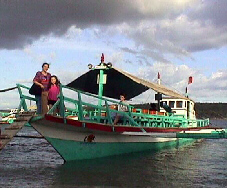
Olive and Maya stand on the bow of the "banca" ready to depart the wharf in Davao, the main city in Southern Philippines, for Samal Island just across the strait. Banca's are long slendor boats with bamboo outrigger floats and are the main transport through most of the Philippine Islands. They can be small one man outrigger canoes or larger motorized passenger vessels.
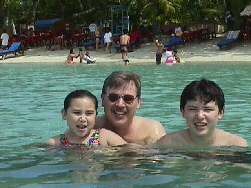
The beach at the Paradise Island Resort was hardly a remote isolated beach. It has a protected swimming area with crystal clear waters, a great open air restaurant, groomed white sand beaches, and luxuriant tropical trees planted to shade the visitors from the mid-day heat. Perfect for the kids and a great place for weary adults to just relax. For beach adventures, one has to hop on a banca and sail a few minutes before you can find your own deserted island.
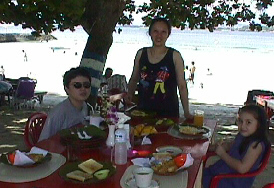
Dining was wonderful. We ate outdoors on rattan plates and banana leaves. The seafood was our favorite -- barbecued Yellowfin Tuna, Blue Marlin fish and chips (the chips were made from plaintains), calamari and shrimp. We also ate lots of fruit and especially enjoyed the fresh papayas, mangos and pineapple.
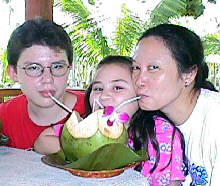
Maybe after we are in the Philippines for a few more years, we will grow tired of fresh coconut juice, but in the five days we were on Samal Island, we could not get enough. The men climbed the coconut palms at the resort to cut the fresh coconuts which the waiters cheerfully served us on the veranda of our beach cabin at any hour of the day complete with an orchid and a straw.
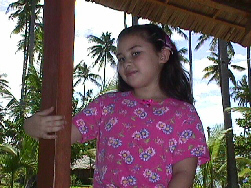
It seemed Maya liked the orchid served with the coconut almost as much as the coconut juice. Here she is posing on the veranda of our beach hut with an orchid in her hair. We loved our thatch roofed beach hut with its woven pandan mat siding and airy veranda. It felt very native but was actually fairly modern with two rooms, four beds, two baths and aircon. I don't think Robinson Crusoe had it quite so nice.
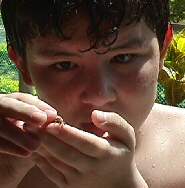
At 13, Mac is a big kid now. Big enough that all the Filippinos are now calling him "sir." Despite his size, he is still all boy. His boyish sense of wonder had him exploring the tidepools at low-tide everyday looking for starfish, hermit crabs and baby octopi. Here he is looking at his small hermit crab pet. He actually learned quite a bit about the habits of hermit crabs studying them in the tidepools.
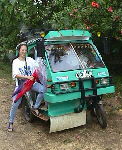
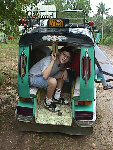
One day it rained, so we took a walk into the little fishing village of Babak. It was about a two and half mile walk in the rain which got us pretty damp even with umbrellas. We decided to take one of the motorized tricycles that are the main public transport on the island back to the resort. They can squeeze up to eight locals into one of these, but the the four of us felt snug enough.
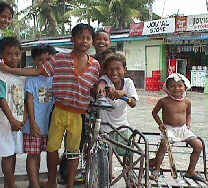
When we reached the thriving metropolis of Babak ( Pop. 1000), the kids were disappointed to learn there was no Baskin Robbins Ice Cream, but we did find a nice little streetside coffee shop. It had great pastries and, as we set there and dried off, we had time to try them all. The local kids were quite enthralled with the foreign visitors and hovered just outside the coffeeshop observing us. Denny used his digital camera to befriend them.
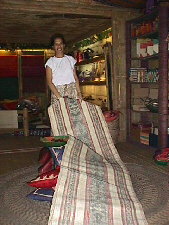
We spent our last night at the Insular Hotel in the City of Davao. The hotel operates a weaving center where local women demonstrate their weaving skills on their handlooms. They use the native abacca fiber to weave beautiful designs. We bought this particular piece to drape along the ceiling in the hallway at the entrance to our house. It was done by a Mandaya woman, one of the tribes in the Southern Philippines.
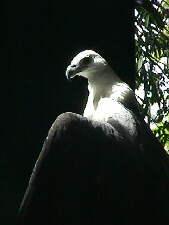
Just before we went to the airport to catch our flight back to Manila, we hired a car and driver to go to the Philippine Eagle Sanctuary. It is a protected tropical rain forest in the hills about 30 km north of Davao where they are breeding the endangered Philippine Eagle. It is the largest eagle in the world with a wing span of about seven feet. The Filipinos constantly reminded me that it was bigger than our American bald eagle. There are only about 120 left and about a dozen of these are the ones bred at the eagle sanctuary. We saw four of them as well as several other varieties of eagles. This is a picture Denny took of the smaller Sea Eagle which is also native to the Philippines. It was a more cooperative photographic subject than its elusive cousin.
CLICK BACK TO THE BARNES FAMILY HOMEPAGE
 Barnes Family Homepage
Barnes Family Homepage











